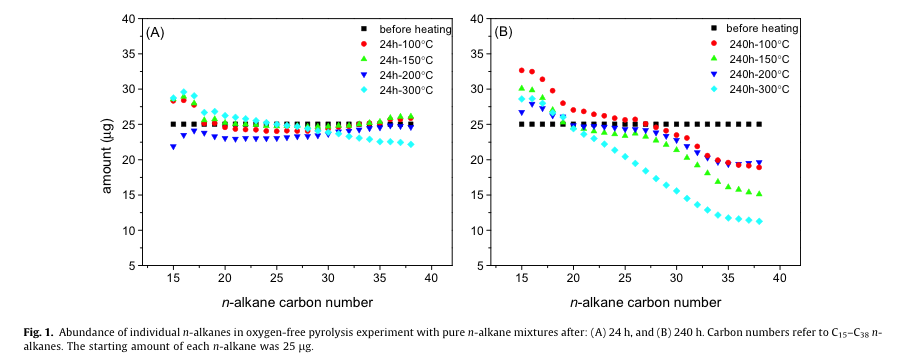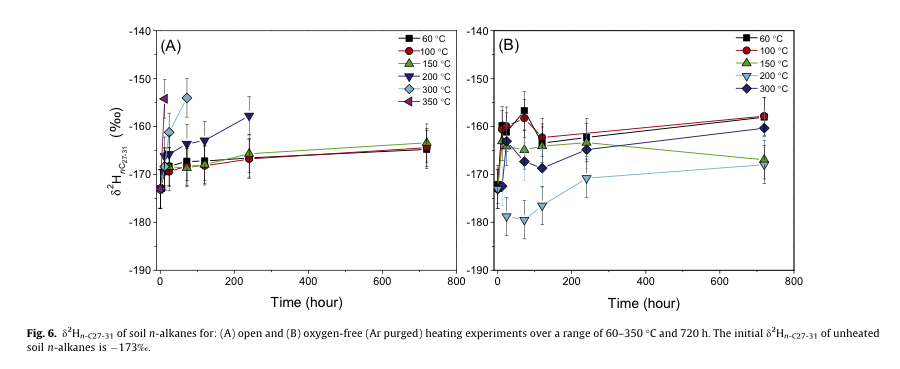Reports: ND256306-ND2: Evaluating the Preservation Potential of Buried Organic Carbon: A Laboratory and Field Study of the Impact of Burial Diagenesis on Stable Isotopic and Organic Molecular Records
Michael Hren, PhD, University of Connecticut
Organic molecular biomarkers provide a novel means of reconstructing past environment, hydrocarbon source or thermal history and are increasingly utilized to understand terrestrial climatic and tectonic evolution. One of the fundamental uncertainties in utilizing organic molecular isotopic proxies is that the effect of burial diagenesis on isotopic composition is still poorly constrained. What are the timescales of exchange, alteration or degradation of the original compounds? How does the temperature/pressure pathway impact original isotopic or molecular signatures?
While there is a large body of work on isotopic and geochemical alteration of organic biomarkers there still remains uncertainty over how much the isotopic composition of specific organic molecular proxies changes over sample-specific P-T paths during burial.
Accurate application of stable isotopic organic molecular proxies requires an answer to three key questions: 1) how do molecular distributions or isotopic composition change during the process of diagenesis, 2) how does the isotopic composition of H or C of target molecules change as a result of isotopic exchange or generation of secondary products and 3) how does the presence of specific soil minerals catalyze isotopic or molecular alteration during this process?
Over the period of funding for this project, PI Hren and students have conducted a series of experiments to assess changes in molecular distributions and stable isotope compositions during heating in the presence or absence of air, water and oxygen, under conditions associated with microbial degradation of compounds, and in the presence of specific soil minerals. These experiments are designed to provide new quantification of the effect of cracking on stable isotope compositions and organic molecular distributions.
There are several key results that arise from this work:
Project 1: Carbon and hydrogen isotope alteration of biomarkers during controlled heating.
We conducted a series of controlled heating experiments of organic soil extracts to assess how C and H isotopes of normal alkanes change due to thermal alteration in the presence or absence of air and water. Results show a clear shift in molecular distributions during the heating process associated with cracking of complex molecules (Figure 1A,B of Wang et al., 2017) and also show clear isotopic fractionation associated with this cracking process (Figure 6 of Wang et al. 2017). However, results show that isotopic fractionation is clearly tied to cracking in the presence of oxygen, such that hydrogen isotopes change by up to 15 per mil during the degradation process. In the absence of oxygen, n-alkanes show little change in hydrogen isotopes. As anticipated, carbon isotopes of the C backbone are more resistant to exchange or alteration, and are stable at temperatures of up to 300 degrees C.
We anticipate submitting a new manuscript on carbon isotope fractionation during cracking in the coming months.
Project 2: Microbial degradation of sedimentary biomarkers and isotope fractionation.
We conducted maturation experiments designed to assess the potential effect of microbial activity in sediments on the hydrogen and carbon isotope composition of n-alkanes. Specifically, we compared the isotopic composition of sedimentary n-alkanes from materials collected and stored in sealed sample containers, with materials collected fresh. We conducted DNA analysis of the sediment to assess whether any changes in molecular distributions or isotopic composition were associated with changes in microbial communities. We show that storage of sediments can affect microbial activity, driving changes in molecular distributions and isotopic composition. (Figure 2 of Brittingham et al., 2017)
These results provide new quantitative measures of the potential magnitude of isotopic alteration associated with degradation of primary organic molecular compounds and the role of microorganisms in mediating this change.
Continuing Work:
As part of the funded ACS research, we have several ongoing projects that we anticipate completing over the next six months.
Project 3: Glycerol dialkyl glycerol tetraethers are a group of compounds produced by archaea in low oxygen environments. The distribution of these compounds are used to constrain past temperature in terrestrial or marine settings. Prior work on these compounds shows preservation of molecular distributions at temperatures of up to ~250 degrees C. We conducted a series of heating experiments (project 1 above) to assess how temperature affects GDGT distributions. Results show potentially significant temperature effects on isoprenoidal GDGTs and will provide constraints on application of this temperature proxy.
Project 4. Clay minerals provide a template for catalyzing cracking reactions of complex organic compounds in sedimentary environments. At present, it is unknown how clay-organic reactions affect the hydrogen and carbon isotopic composition of biomolecules. We are conducting a series of experiments to assess how different clay minerals affect isotopic fractionation during burial heating. Results of this work have implications for understanding sedimentary biomarker isotope records as well as the role of clays in organic catalysis reactions. We anticipate submitting a draft manuscript on this work in the Winter of 2018.














